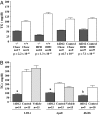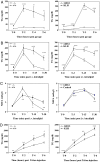Lipid-lowering effects of anti-angiopoietin-like 4 antibody recapitulate the lipid phenotype found in angiopoietin-like 4 knockout mice
- PMID: 17609370
- PMCID: PMC1913890
- DOI: 10.1073/pnas.0705041104
Lipid-lowering effects of anti-angiopoietin-like 4 antibody recapitulate the lipid phenotype found in angiopoietin-like 4 knockout mice
Abstract
We used gene knockout mice to explore the role of Angiopoietin-like-4 (Angptl4) in lipid metabolism as well as to generate anti-Angptl4 mAbs with pharmacological activity. Angptl4 -/- mice had lower triglyceride (TG) levels resulting both from increased very low-density lipoprotein (VLDL) clearance and decreased VLDL production and had modestly lower cholesterol levels. Also, both Angptl4 -/- suckling mice and adult mice fed a high-fat diet showed reduced viability associated with lipogranulomatous lesions of the intestines and their draining lymphatics and mesenteric lymph nodes. Treating C57BL/6J, ApoE -/-, LDLr -/-, and db/db mice with the anti-Angptl4 mAb 14D12 recapitulated the lipid and histopathologic phenotypes noted in Angptl4 -/- mice. This demonstrates that the knockout phenotype reflects not only the physiologic function of the Angptl4 gene but also predicts the pharmacologic consequences of Angptl4 protein inhibition with a neutralizing antibody in relevant models of human disease.
Conflict of interest statement
Conflict of interest statement: All authors are or have been employed by Lexicon Pharmaceuticals, Inc., and may own publicly traded stock in Lexicon. The research was supported by Lexicon.
Figures




Similar articles
-
Identification of a new functional domain in angiopoietin-like 3 (ANGPTL3) and angiopoietin-like 4 (ANGPTL4) involved in binding and inhibition of lipoprotein lipase (LPL).J Biol Chem. 2009 May 15;284(20):13735-13745. doi: 10.1074/jbc.M807899200. Epub 2009 Mar 23. J Biol Chem. 2009. PMID: 19318355 Free PMC article.
-
Angptl4 upregulates cholesterol synthesis in liver via inhibition of LPL- and HL-dependent hepatic cholesterol uptake.Arterioscler Thromb Vasc Biol. 2007 Nov;27(11):2420-7. doi: 10.1161/ATVBAHA.107.151894. Epub 2007 Aug 30. Arterioscler Thromb Vasc Biol. 2007. PMID: 17761937
-
Transgenic angiopoietin-like (angptl)4 overexpression and targeted disruption of angptl4 and angptl3: regulation of triglyceride metabolism.Endocrinology. 2005 Nov;146(11):4943-50. doi: 10.1210/en.2005-0476. Epub 2005 Aug 4. Endocrinology. 2005. PMID: 16081640
-
Regulation of triglyceride metabolism by Angiopoietin-like proteins.Biochim Biophys Acta. 2012 May;1821(5):782-9. doi: 10.1016/j.bbalip.2011.10.010. Epub 2011 Oct 25. Biochim Biophys Acta. 2012. PMID: 22063269 Review.
-
Impacts of angiopoietin-like proteins on lipoprotein metabolism and cardiovascular events.Curr Opin Lipidol. 2010 Feb;21(1):70-5. doi: 10.1097/MOL.0b013e328333269e. Curr Opin Lipidol. 2010. PMID: 19851103 Review.
Cited by
-
A novel NanoBiT-based assay monitors the interaction between lipoprotein lipase and GPIHBP1 in real time.J Lipid Res. 2020 Apr;61(4):546-559. doi: 10.1194/jlr.D119000388. Epub 2020 Feb 6. J Lipid Res. 2020. PMID: 32029511 Free PMC article.
-
ANGPTL4: a multifunctional protein involved in metabolism and vascular homeostasis.Curr Opin Hematol. 2020 May;27(3):206-213. doi: 10.1097/MOH.0000000000000580. Curr Opin Hematol. 2020. PMID: 32205586 Free PMC article. Review.
-
From Congenital Disorders of Fat Malabsorption to Understanding Intra-Enterocyte Mechanisms Behind Chylomicron Assembly and Secretion.Front Physiol. 2021 Jan 27;12:629222. doi: 10.3389/fphys.2021.629222. eCollection 2021. Front Physiol. 2021. PMID: 33584351 Free PMC article. Review.
-
Pemafibrate Induces a Low Level of PPARα Agonist-Stimulated mRNA Expression of ANGPTL4 in ARPE19 Cell.Bioengineering (Basel). 2024 Dec 9;11(12):1247. doi: 10.3390/bioengineering11121247. Bioengineering (Basel). 2024. PMID: 39768065 Free PMC article.
-
Adipose tissue angiogenesis: impact on obesity and type-2 diabetes.Biochim Biophys Acta. 2014 Mar;1842(3):463-72. doi: 10.1016/j.bbadis.2013.06.003. Epub 2013 Jun 12. Biochim Biophys Acta. 2014. PMID: 23770388 Free PMC article. Review.
References
-
- Kersten S, Mandard S, Tan NS, Escher P, Metzger D, Chambon P, Gonzalez FJ, Desvergne B, Wahli W. J Biol Chem. 2000;275:28488–28493. - PubMed
-
- Ge H, Cha JY, Gopal H, Harp C, Yu X, Repa JJ, Li C. J Lipid Res. 2005;46:1484–1489. - PubMed
-
- Yoshida K, Shimizugawa T, Ono M, Furukawa H. J Lipid Res. 2002;43:1770–1772. - PubMed
MeSH terms
Substances
LinkOut - more resources
Full Text Sources
Other Literature Sources
Medical
Molecular Biology Databases
Miscellaneous

